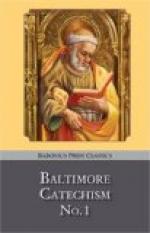Even some pagans who came to see the Christians put to death were so touched by their patience, fortitude, courage, and constancy, that they also declared themselves anxious to become Christians, and were put to death, thus becoming martyrs baptized in their own blood. How many lessons we may learn from all this: (1) How very respectful we should be in the Church, which is holy for all the reasons I have given. (2) What a shame it is for us not to hear Mass when we can do so easily. Our churches are never very far from us, and generally well lighted, ventilated, furnished with seats and every convenience, and in these respects unlike the dark, damp, underground churches of the early Christians. Moreover, we may attend our churches freely and without the least danger to our lives; while the Christians of the early ages were constantly in dread and danger of being seized and put to death. Even at the present day, in many countries where holy missionaries are trying to teach the true religion, their converts sometimes have to go great distances to hear Mass, and even then it is not celebrated in comfortable churches, but probably on the slope of a rugged mountain or in some lonely valley or wood where they may not be seen, for they fear if they are captured—as often happens—both they and their priest will be put to death. You can read in the account of foreign missions that almost every year some priests and many people are martyred for their faith. Is it not disgraceful, then, to see some Catholics giving up their holy faith and the practice of their religion so easily—sometimes for a little money, property, or gain; or even for a bad habit, or for irreligious companions and friends? What answer will they make on the day of judgment when they stand side by side with those who died for the faith?
“All those who profess the faith,” etc. The Pope, bishops, priests, and people all taken together are the Church, and each congregation or parish is only a part of the Church.
“Partake”—that is, receive. “Lawful pastors”—that is, each priest in his own parish, each bishop in his own diocese, and the Pope throughout the world. “Visible head”—that is, one who can be seen, for invisible means cannot be seen.
116 Q. Who is the invisible head of the Church? A. Jesus Christ is the invisible head of the Church.
“Invisible head.” If, for example, a merchant of one country wishes to establish a branch of his business in another, he remains in the new country long enough to establish the branch business, and then appointing someone to take his place, returns to his own country. He is still the head of the new establishment, but its invisible head for the people of that country, while its visible head is the agent or representative he has placed in charge to carry on the business in his name and interest. When Our Lord wished to establish His Church He came from Heaven; and when about to return to Heaven appointed St. Peter to take His place upon earth and rule the Church as directed. You see, therefore, that Our Lord, though not on earth, is still the real head and owner of the Church, and whatever His agent or vicar—that is, our Holy Father, the Pope—does in the Church, he does it with the authority of Our Lord Himself.




